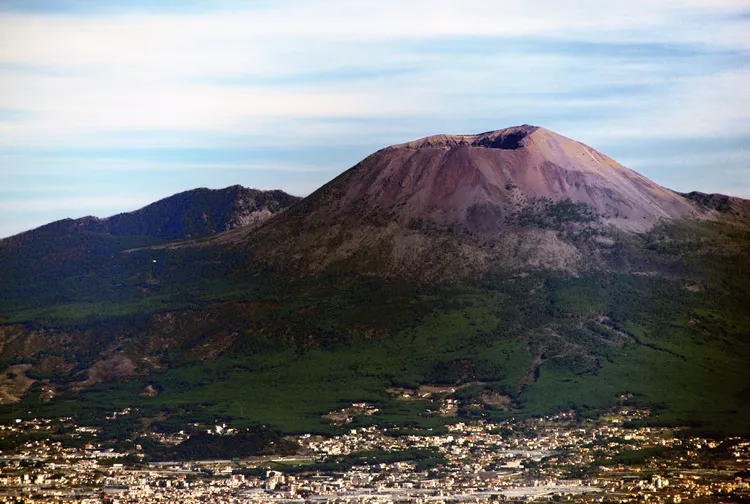Summary
Mount Vesuvius, the massive, active volcano that looms over the Bay of Naples and the Campania region, was responsible for the destruction of Roman towns Pompeii and Herculaneum in 79 AD. Vesuvius last erupted in 1944, with Allied fliers taking photos of the eruption.
What we call “Vesuvius” is the younger part of the mountain complex that geologists refer to as “Greater Vesuvius.” The older mountain, now an extinct volcano, is called Monte Somma. A fresco recovered from Pompeii depicts a single summit and the much taller Monte Somma before the eruption of 79 AD.
In 1995, the area around Vesuvius was designated as the Parco Nazionale del Vesuvio, the National Park of Vesuvius.
Current Dangers
It is estimated that 2.5 million people could be affected by a significant eruption of Vesuvius. Consequently, conditions are closely monitored. There is an evacuation plan for the immediate areas around the volcano that assumes a notice period of between two weeks and 20 days prior to any potential eruption.
Viewing the Crater
Buses can take visitors to within 200 meters of the summit of Vesuvius. Here, visitors can purchase tickets to the top along with refreshments, souvenirs, and clothing. Moreover, it is crucial to remember that temperatures at the summit can be considerably cooler, especially when low clouds are present.
Once your ticket is acquired, you will ascend on a wide trail made up of volcanic stone, which is sometimes lined with larger rocks. Sturdy shoes are recommended for this trek. The trail has multiple switchbacks and circles the crater, with refreshments available at both the summit and an intermediate point along the trail.
At the summit, visitors have the option to hire a guide, purchase a guidebook, or simply enjoy a peek into the crater independently.
Walking the Trail to the Summit
Formerly, a funicular provided easy access to the summit of Mount Vesuvius; however, it has since been dismantled. Therefore, visitors must walk to the summit to experience the crater, although excellent views of Naples and the Bay of Naples can be enjoyed from the parking area.
The trail is a wide path composed of volcanic stones, intermingled with larger rocks that have likely fallen from above. The trails are equipped with guard rails for safety. The steep and constant grade means that a moderately conditioned individual can expect to reach the refreshment stand at the summit in approximately 20 minutes, where guides are available for hire or will be awaiting tour groups. Passing through clouds or fog is a common occurrence during spring.
Reaching the Summit
At the rim of the crater of Mount Vesuvius, visitors can enjoy food and drink, purchase guidebooks, or hire a guide for a more informative experience.
Bay of Naples View From Mount Vesuvius
About halfway up, climbers can witness the lava flow from the 1944 eruption of Vesuvius, along with stunning views of Naples and the Bay of Naples.
Crater and Fumaroles
This section of the Grand Cono displays the active fumaroles that emit a steady stream of steam around the crater’s rim.
The crater itself is 1,282 meters above sea level, 230 meters deep, and approximately 650 meters in diameter.
Things to Do in the Area
Vesuvius is often a popular day-trip destination from Naples. The area is renowned for its delicious food, largely due to the fertile soil formed by volcanic ash on the slopes of Vesuvius.
The ancient towns destroyed in the 79 AD eruption offer intriguing excursions. The ash and lava that enveloped Pompeii and Herculaneum have preserved them in a manner rarely witnessed in Italian archaeological sites.
Additionally, the Amalfi Coast, a World Heritage Site, is one of Italy’s most coveted destinations, making it another remarkable option for visitors exploring the region.




